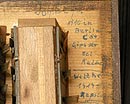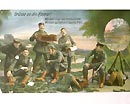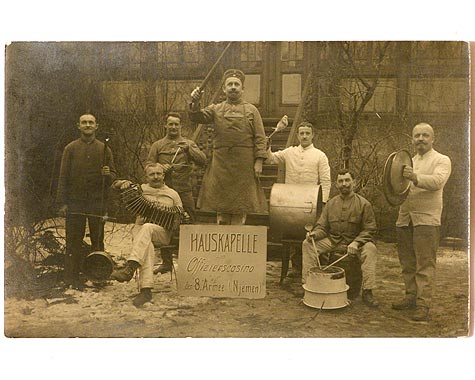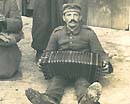
Bandonion
112 tones
bisonoric
(Collection Oriwohl, Nr. 349)
Manufacture: Co. J.F. Kalbe (Berlin, founded 1840), around 1900. 2-choirs (8'+4')
An instrument with a moving inner life...


Left side:
Bandonion with curriculum vitae
Furthermore, at the lower ends of the right and middle soundposts, the attachments of a later tone extension are visible.


"Joh. Behm 1910 in Berlin C54 Gipsstr.[eet] bei Kalbe
Weltkr [World war] 1914- Rußsl [Russia]..."
Probably played by the father Joh. Behm in the 1st World War...


...and by the son Geh. Behm in the second:
"Gerh. Behm 1944-45 Gotenhafen, Reval Estl, Libau Lett, Saßnitz a Rü, 1946-50 Köln-Rhein, Ahr, Eifel, Westfalen"


"From the trenches.
Sing to whom song is given."
On this propaganda postcard from the 1st World War became war cries to war songs.
In clean uniform, in dry weather and firelight only from a distance, the rifle can rest on the earthen embankment and its bearer can devote himself entirely to the muse. Pure war romanticism - shooting as a secondary matter.
Whether the bandonion of the Behms in two wars also played in such luxurious front furniture, may be doubted. The appearance of the bandonion in propaganda testifies to its widespread use at that time.


""Greetings to the homeland!
Where one sings the happy songs,
Where one speaks a trusting word."


"8. Korp, 28.9.14"


War postcard from the 1st World War


"House Chapel, Officers' Mess of the 8th Army (Njemen)" in the 1st World War.
The only factory-made instrument in the "House chapel" was the accordion. To the left of this the "devil's violin", a large tin can, preferably of Bismarck pegs, was attached to a stick. By hitting the stick or by stamping on the floor, sounds could be produced for rhythmic accompaniment.


This is how Joh. Behm might have looked with his bandonion.
